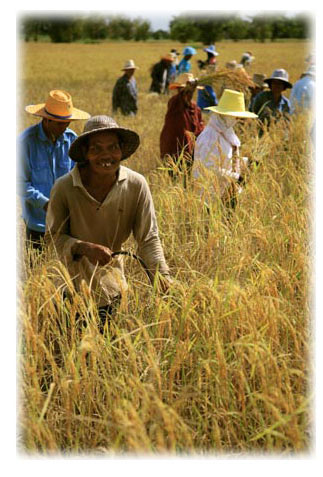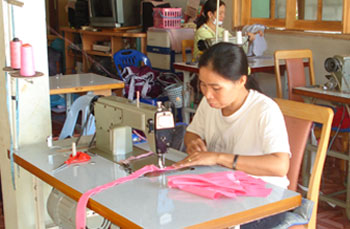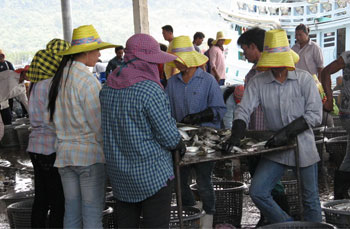“Indirect” Policies on Internal Migration in Thailand: Implications from the “National and Regional Migration Surveys” of IPSR in the past.
In the early 1990s, IPSR conducted the National Migration Survey of Thailand (NMS). Funded by the Canadian International Development Agency (CIDA), the survey included complete migration and life histories for a nationally-representative sample. It was the first study to give national and regional estimates of circular, seasonal and long-term migration in Thailand. A longitudinal follow-up survey then revisited the households from the Northeast to investigate changes in the two years following the first survey. NMS2 was funded by the Ford Foundation and was conducted in 1994.
It is fascinating to note that the policy analysis drawn from these two surveys contains many issues that are still relevant today. For internal migration in Thailand, migration policies are only “indirect.” Rural development and other forms of economic stimulus may influence individual decision-making, but in the end individuals and households make migration decisions based on their own perceptions of the costs and benefits. This fact remains, even with the vast changes in local development that have resulted from decentralization and new government stimulus programs in the past fifteen years.
Indirect Policies from the National Migration Survey of Thailand (NMS)
Excerpted with minor revision from
Aphichat Chamratrithirong, , Krittaya Archavanitkul, Kerry Richter, Philip Guest,
Varachai Thongthai, Wathinee Boonchalaksi, Nittaya Piriyathamwong and Panee Vong-Ek 1995.
National Migration Survey of Thailand. IPSR Publication No.188
The data of this survey are available upon request at http://opr.princeton.edu/archive/nmst/
1. Promotion of Rural Sustainability
The rate of migration revealed in the national survey, especially the migration into and out of Bangkok, is much higher than in past estimates.  This high rate of migration reflects changing social processes which should concern policy makers involved in development planning.
This high rate of migration reflects changing social processes which should concern policy makers involved in development planning.
Generally, urban and rural development determine the population density in both areas. To reduce or to slow down migration streams to Bangkok and its periphery areas and to increase the attraction of alternative destination towns or cities, the previous and the current National Plans have focused on “spatial aspects” rather than “human aspects” of development. This has led to the urbanization of Bangkok and large provincial towns, while widening the range of destination places for migrants. Note that equitable development for all entails population distributions that center on the people.
Development which centers on people suggests the promotion of rural sustainability. It also implies a fair share of national resources and the generation of awareness among rural people so they can live with dignity. People in rural communities should be provided with equal access to knowledge and information necessary for the improvement of their living standard. Fair distribution of educational opportunities, self-governance authority and equitable share of government budgets for rural people, and respect for local wisdom are important factors for sustainable development.
In most cases, people move because they want to seek better opportunities in life. As long as the people are free to move from one place to another, the search for better life through migration will continue. Apart from absolute dictatorship, there is no migration policy or development plan that can completely halt migration.
Rural development and pro-poor policies are therefore development policy, and not direct “migration policy”.
2. Public Information Centre for Migrants
Findings from the national survey strongly suggest that the government’s news and information services especially for rural-to-urban migrants should be improved. A public information center for potential migrants should be set up, particularly for temporary labor migrants in Bangkok and other popular destinations such as Chiengmai, Phuket, and Cholburi. More serious attention should be paid to prevent rural migrants from being lured, oppressed or taken advantage of. The government should be able to guarantee sufficient welfare for rural migrants while they are at the place of destination.
3. Nationwide Information on Available Jobs for Seasonal Migrants
 Migration should be supported as one of the mechanisms through which people can take advantage of better opportunities in life. Seasonal migration is an excellent example. If seasonal rural-to-urban migration continues and low-educated people tend to seasonally migrate, how can disadvantaged people attain the highest benefit from their migration? For instance, information support to temporary migrants on how to effectively manage their time and work, both in rural communities and in urban areas, is critically needed. Some of the funds being directed towards temporary employment creation schemes in rural areas could be used to make migration a more effective way of attaining migrants’ goals.
Migration should be supported as one of the mechanisms through which people can take advantage of better opportunities in life. Seasonal migration is an excellent example. If seasonal rural-to-urban migration continues and low-educated people tend to seasonally migrate, how can disadvantaged people attain the highest benefit from their migration? For instance, information support to temporary migrants on how to effectively manage their time and work, both in rural communities and in urban areas, is critically needed. Some of the funds being directed towards temporary employment creation schemes in rural areas could be used to make migration a more effective way of attaining migrants’ goals.
Apart from their current effort to create job opportunities in rural villages during the dry season (which is limited in terms of the number of jobs created and the areas covered), the government should try to gather nationwide information on job opportunities for seasonal migrants. Active government steps in the dissemination of their information to people throughout the country especially in rural villages as well as in destination town and cities are highly recommended. This need is more pressing in places with high levels of temporary migration, such as in the Northeastern and Northern provinces. Initiatives undertaken by the government in preparation for seasonal and temporary migration will assist migrants and the society as a whole in gaining greater benefit from the rapidly increasing levels of migration.
4. Welfare for Female and Young Migrants in the Informal Sector
Since the migration rates of male and female migrants are almost equal, various problems concerning the female labor force should be seriously addressed. Priority areas of concern regarding the female force are equal wages and welfare, the right to take maternity leave, and protection from being lured into the sex industry or other forms of exploitation.
The majority of migrants are young people, so the government should allocate more money for the provision of facilities such as informal education and vocational training for these migrants. The increased human resources of young migrants will eventually rebound to the benefit of the country.
5. Promotion of Local Migration Networks
Local networks based on successful migration should be also promoted in addition to formal information services for job opportunities. The findings from the national survey are consistent with previous migration studies, which showed the importance of migration information through local networks. News and information are passed on from previous migrants to the people in their rural villages. Relevant information passed on within these networks include experiences in migration, eventual success or failure, sources of employment, prospective incomes, and ways of living in destination places. The information passed on through these local networks is found to be most influential in decisions regarding whether to move and where to migrate.
We strongly recommend that local state offices make use of the local networks in promoting successful migration. Steps should be taken to facilitate people from the same areas living together at the destination places. Communication systems such as the mobile phone and community media can also help prevent rural migrants’ failure due to a lack of migration information.
6. Constructive Use of Remittances
How can the powerful government administration network encourage rural people to spend migrants’ remittances towards the promotion of their quality of life? Migrants’ incomes should be spent in a way that would strengthen the family institution, rural communities, and benefit the migrants themselves. Money should be directed towards human resource investments rather than just spent for consumption goods. Such income could also encourage rural people to retain possession of their land. With the strong linkages between migrants and their families as well as their places of origin, migrants need never abandon their home communities.
In conclusion, temporary migration will help promote the sustainability of both rural and urban communities of the nation through these recommended policies. Rural-urban migration without totally abandoning the rural areas is also a protective and absorptive mechanism against economic downturn. Migrants should be empowered. Policies aimed at discouraging rural-urban migration, including temporary and seasonal migration, are likely to place rural communities at a disadvantage.
Indirect Policies from the Northeast Regional Follow-up Survey (NMS2)
Kerry Richter, Philip Guest, Wathinee Boonchalaksi, Nittaya Piriyathamwong
and Nimfa B. Ogena. 1997.
Migration and the Rural Family: Sources of Support and Strain in a Mobile Society.
IPSR Publication No.190
Following are suggestions for policy development that arise from this research. Many of these follow from a seminar held in Bangkok on July 28, 1995 to present the results of the NMS2 study. In the afternoon session, participants broke into small groups to discuss the implications of the study, and of migration in Thailand in general, for national policy. Recommendations that emerged from that seminar, in combination with those suggested by the NMS2 research team, are drawn directly from the findings of this research.
 1. One of the major findings from the study was that many of those who migrated would prefer to stay home if they could make sufficient income. These include many of the older
1. One of the major findings from the study was that many of those who migrated would prefer to stay home if they could make sufficient income. These include many of the older
seasonal migrants with children; but also include some young single migrants who would prefer not to migrate. For this reason development efforts should be directed towards allowing rural residents to make a sustainable livelihood in their home communities. Programs could include expanded agricultural extension activities; expansion of crop varieties that would provide year-round income; social marketing to aid farmers in gaining income from new crops; and expansion of irrigation facilities. These activities would help farmers to be financially independent. Another suggestion is the establishment of community-based investment counseling centers in rural areas. Advice about possible business ventures to pursue, whether in the home community or outside, and appropriate referrals for the training of new entrepreneurs in business management and technology transfer, should be provided. One of these centers’ major goals should be to increase the production of value-added commodities in the villages. These centers would also aid migrants in making better and longer-term use of remittance income.
 2. For other migrants, we have seen that there are certain attractions that migration provides, particularly to urban areas, that could nonetheless be re-directed. Young people often stated that they were motivated by the desire to gain experience in different kinds of occupations and to have new social experiences, even while they ultimately wanted to return home. Also those with more education and/or vocational skills were less likely to be motivated by government policies that would simply provide cash income for staying home. For this group, policies must be implemented to improve the quality of life and job opportunities in rural areas. Rural development schemes would include further investment in the infrastructure in rural areas; improved educational facilities; and expanded employment opportunities. Industrialization thus may spread into the countryside, but with sustainable development as a goal. This would include incentives for private industry to build small factories that do not overload the infrastructure of rural communities or create an undesirable environment.
2. For other migrants, we have seen that there are certain attractions that migration provides, particularly to urban areas, that could nonetheless be re-directed. Young people often stated that they were motivated by the desire to gain experience in different kinds of occupations and to have new social experiences, even while they ultimately wanted to return home. Also those with more education and/or vocational skills were less likely to be motivated by government policies that would simply provide cash income for staying home. For this group, policies must be implemented to improve the quality of life and job opportunities in rural areas. Rural development schemes would include further investment in the infrastructure in rural areas; improved educational facilities; and expanded employment opportunities. Industrialization thus may spread into the countryside, but with sustainable development as a goal. This would include incentives for private industry to build small factories that do not overload the infrastructure of rural communities or create an undesirable environment.
3. We have seen that migration is a selective process, and that the outflow of the young and more educated has drained the resources of the rural areas. For this reason, human resource development should include training for rural people in vocations suitable to the modern job market. Increased knowledge of employers needs and dissemination of this information is necessary to make employee’s skills better suit the emerging job market. This includes both formal and informal educational systems, and should include older people as well as younger people and children. In order to be competitive not only in the domestic but more importantly in the international labor market, strong incentives should be placed for the retention of students currently in school and in encouraging young adults to return to school for long-term economic benefits not only for personal but also for village and national interests. Return migrants should particularly be targeted for these programs. Hence, studies identifying factors that could facilitate massive human resource development should be encouraged and fully supported.
4. For the same reasons, social programs are needed for families left behind, especially in regard to children and the elderly. This includes the need for supportive care as well as provision of basic needs. Households with out-migrants were found to have the lowest base incomes as well as lower levels of remittances, pointing out the importance of this group as a target for programs combating rural poverty.
5. Because migration is a long-term pattern in the rural Northeast, it is unlikely that migration flows can be completely stemmed. Thus it is important to re-direct migration flows to  make the migration process more systematic and efficient. This would include working with migrants’ already strong social networks and information flows. Migrants should be provided with information on employment opportunities using a bottom-up approach; for example, return migrants can contribute to a central job bank. The government and NGO’s should take a more active role in providing this information to migrants, including that regarding more local opportunities. Regional centers responsible for aiding migrants should be established that would match skill of workers with needs of employers. This would include the development of a databank on labor force, skills, training, employment and investment information at the village level. A coordinating body would organize inputs from community residents, various government and non-governmental organizations and put this information online, updated on a quarterly basis, using the new information technology (IT). Being online, the databank should be accessible not only for potential migrants, through the establishment of village data-retrieval points throughout the country, but also for national development planning. Plans for the location of new industrial sites and/or subsidiary branches should take into account the information provided by the databank to reduce labor force displacements and to disperse the economic growth zones. Plans for making the databank
make the migration process more systematic and efficient. This would include working with migrants’ already strong social networks and information flows. Migrants should be provided with information on employment opportunities using a bottom-up approach; for example, return migrants can contribute to a central job bank. The government and NGO’s should take a more active role in providing this information to migrants, including that regarding more local opportunities. Regional centers responsible for aiding migrants should be established that would match skill of workers with needs of employers. This would include the development of a databank on labor force, skills, training, employment and investment information at the village level. A coordinating body would organize inputs from community residents, various government and non-governmental organizations and put this information online, updated on a quarterly basis, using the new information technology (IT). Being online, the databank should be accessible not only for potential migrants, through the establishment of village data-retrieval points throughout the country, but also for national development planning. Plans for the location of new industrial sites and/or subsidiary branches should take into account the information provided by the databank to reduce labor force displacements and to disperse the economic growth zones. Plans for making the databank  operational should be done in conjunction with the current IT efforts at
operational should be done in conjunction with the current IT efforts at
6. Besides efforts to stem migration flows and make the process more efficient, efforts should be made to re-direct migration away from over-crowded destination communities, namely Bangkok. This would include policies to decentralize employment opportunities, including incentives for employers to locate outside of the Bangkok metropolitan area, and continued movement of higher education facilities including universities and vocational/technical training. The government should take amore aggressive and active role in the employment process, with the Board of Investment doing more to decentralize employment. Incentives, such as a differential tax structure, should encourage the private sector to get involved in the employment process. The private sector should also be more responsible for training and human resource development.